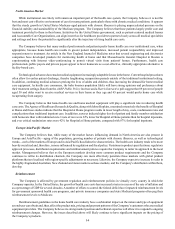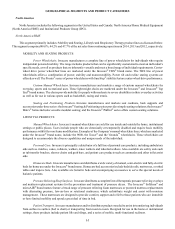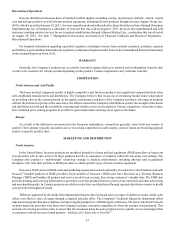Invacare 2014 Annual Report Download - page 17
Download and view the complete annual report
Please find page 17 of the 2014 Invacare annual report below. You can navigate through the pages in the report by either clicking on the pages listed below, or by using the keyword search tool below to find specific information within the annual report.I-13
See Item 1A. Risk Factors and Item 7. Management’s Discussion and Analysis of Financial Condition and Results of
Operations for further discussion of these matters.
Other FDA Matters.
In December 2010, the Company received a warning letter from the FDA related to quality system processes and procedures
at the Company's Sanford, Florida facility. In October 2014, the FDA conducted an inspection at the Sanford facility and, at the
conclusion, issued its Form 483 containing four inspectional observations, three of which related to complaint handling and CAPA
and a fourth related to production process controls. The Company has timely filed its response with the FDA and continues to
work on addressing the FDA observations. At the time of filing of this Annual Report on Form 10-K, this matter remains pending.
See Item 1A. Risk Factors.
In January 2014, the FDA conducted inspections at the Company’s manufacturing facility in Suzhou, China and at the
Company’s electronic components subsidiary in Christchurch, New Zealand, covering quality systems and current Good
Manufacturing Practice regulations. In August 2014, the FDA inspected Alber GmbH in Albstadt, Germany. The FDA issued its
inspectional observations on Form 483 to the Company after these inspections, and the Company submitted its responses to the
agency in a timely manner.
From time to time, the Company may undertake voluntary recalls or field corrective actions of the Company’s products to
correct product issues that may arise. These actions are necessary to ensure the Company's products adhere to high standards of
quality and safety. The Company continues to strengthen its programs to better ensure compliance with applicable regulations and
actively keeps abreast of proposed regulations, particularly those which could have a material adverse effect on the Company.
During 2014, the Company initiated a recall related to a component in a stationary oxygen concentrator that was manufactured
in the Company’s facility in Suzhou, China, and sold globally. In addition, the Company initiated a recall of a sieve bed component
used within stationary oxygen concentrators manufactured in the Company's facility in Sanford, Florida during August 2014 and
impacted the North America/HME segment. Finally, the Company continued to conduct the joystick recall that was launched in
2013, which involved the replacement of potentially affected joysticks due to an anomaly discovered in a portion of the joystick
components in the field. This recall impacted the North America/HME and Asia/Pacific segments. The Company has warranty
reserves for these recalls, which are discussed further in the "Current Liabilities" and “Contingencies” Notes to the Condensed
Consolidated Financial Statements included in this Annual Report on Form 10-K.
National Competitive Bidding.
With respect to reimbursement in the United States, the Centers for Medicare and Medicaid Services (CMS) began
implementation on January 1, 2011 of the National Competitive Bidding (NCB) program in nine metropolitan areas across the
country (Round 1). On July 1, 2013, CMS expanded the program to an additional 91 metropolitan areas (Round 2). These bid
programs have resulted in new, lower Medicare payment rates in these 100 areas. CMS rebids these areas every three years and
hence a second round of contracts began in the nine Round 1 areas on January 1, 2014. The Company remains judicious in its
extension of credit to customers and monitors whether other payors begin to model their payments on the NCB program. The
Company also closely watches state Medicaid budgets and how deficits may impact coverage and payments for home medical
equipment and institutional care products.
Although reductions in Medicare payments are not beneficial to the homecare industry, the Company believes that, over the
long term, it can still grow and thrive in this environment. No significant cost-of-living adjustments have been made over the last
few years to the reimbursement and payment amounts permitted under Medicare with respect to the Company’s products, but the
Company intends to respond with improved productivity. In addition, the Company’s respiratory therapy products (for example,
the low-cost HomeFill® oxygen delivery system) can help offset the Medicare reimbursement cuts to the homecare provider. The
Company intends to focus on developing products that help the provider improve profitability. Additionally, the Company continues
to focus on low-cost country sourcing and/or manufacturing to help ensure that the Company is one of the lowest cost manufacturers
and distributors.
BACKLOG
The Company generally manufactures most of its products to meet near-term demands by shipping from stock or by building
to order based on the specialty nature of certain products. Therefore, the Company does not have substantial backlog of orders of
any particular product nor does it believe that backlog is a significant factor for its business.
























